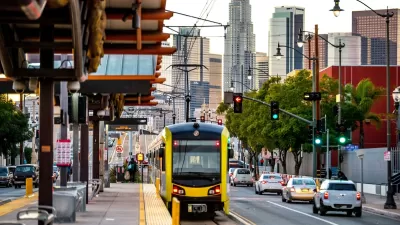Matthew Yglesias reports on how Los Angeles is embracing its natural advantages to become an "ideal transit city," matching its transit investments with improvements to the built environment.
According to Yglesias, LA's investments are paying off, with a dramatic increase in transit use, and a coordinated effort to match its planning functions with transit goals:
"[Los Angeles] is acting to transform the built environment to match the [transit] infrastructure. A controversial plan to rezone the Hollywood area for more density has passed. The city has also moved to reduce the number of parking spaces developers need to provide with new projects, following the lead of the smaller adjacent cities of Santa Monica and West Hollywood. A project to reconfigure Figueroa Boulevard running south from downtown toward Exposition Park as a bike-and-pedestrian friendly byway is in the works, and pending the outcome of a November ballot initiative, a streetcar may be added to the mix. At the northern end is the of movie theaters, restaurants, arenas, hotels, condos, and apartments-the biggest downtown investment the city had seen in decades, constructed between 2005 and 2010. At the southern end of the corridor is the University of Southern California, which is planning to redevelop its own backyard to look a bit more like a traditional urban university village.
Los Angeles continues, like almost all American cities, to be primarily automobile oriented. But the policy shift is having a real impact on the ground."
FULL STORY: L.A.’s Transit Revolution

Alabama: Trump Terminates Settlements for Black Communities Harmed By Raw Sewage
Trump deemed the landmark civil rights agreement “illegal DEI and environmental justice policy.”

Planetizen Federal Action Tracker
A weekly monitor of how Trump’s orders and actions are impacting planners and planning in America.

The 120 Year Old Tiny Home Villages That Sheltered San Francisco’s Earthquake Refugees
More than a century ago, San Francisco mobilized to house thousands of residents displaced by the 1906 earthquake. Could their strategy offer a model for the present?

In Both Crashes and Crime, Public Transportation is Far Safer than Driving
Contrary to popular assumptions, public transportation has far lower crash and crime rates than automobile travel. For safer communities, improve and encourage transit travel.

Report: Zoning Reforms Should Complement Nashville’s Ambitious Transit Plan
Without reform, restrictive zoning codes will limit the impact of the city’s planned transit expansion and could exclude some of the residents who depend on transit the most.

Judge Orders Release of Frozen IRA, IIJA Funding
The decision is a victory for environmental groups who charged that freezing funds for critical infrastructure and disaster response programs caused “real and irreparable harm” to communities.
Urban Design for Planners 1: Software Tools
This six-course series explores essential urban design concepts using open source software and equips planners with the tools they need to participate fully in the urban design process.
Planning for Universal Design
Learn the tools for implementing Universal Design in planning regulations.
Clanton & Associates, Inc.
Jessamine County Fiscal Court
Institute for Housing and Urban Development Studies (IHS)
City of Grandview
Harvard GSD Executive Education
Toledo-Lucas County Plan Commissions
Salt Lake City
NYU Wagner Graduate School of Public Service



























